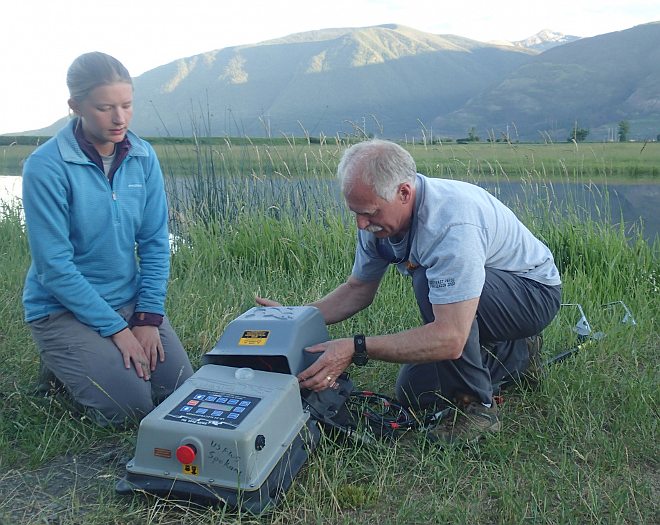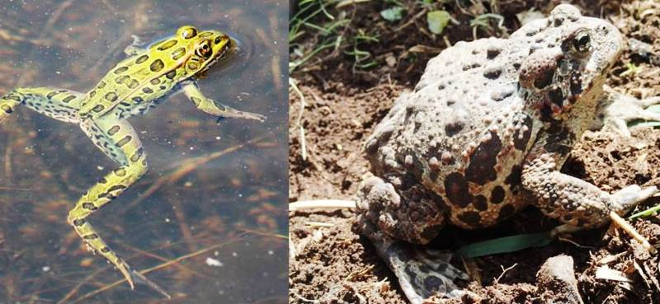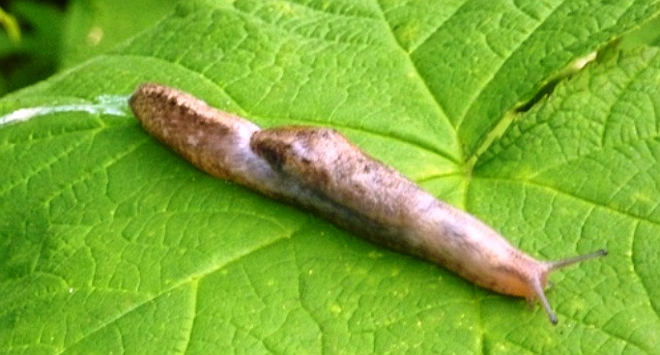|
'Electrofrogging' clears way for climate
adaptation grant |
|
November 8, 2017 |
 |
| Fish and Game Senior Wildlife
Diversity Technician Leah Swartz and
BCME Habitat Biologist Terry Anderson
prepare equipment for a night of work
electrofrogging. |
|
By Michael Lucid
IDFG Wildlife Regional Biologist
An invasive frog in the wetlands of North Idaho
is triggering climate related habitat work in
Boundary County. In recent years, warm
temperature loving American bullfrogs have been
making their way north along the Kootenai River
Valley toward the Boundary-Smith Creek Wildlife
Management Area (BSCWMA) near the US-Canadian
border.
Bullfrogs threaten native amphibians and pose an
immediate threat to the last natural colony of
native Northern leopard frogs in the
northwestern portion of that species range. This
bullfrog invasion has spurred emergency
international bullfrog control actions and
inspired Idaho Fish and Game and partners to
obtain funding to manage the WMA to benefit
several climate sensitive Species of Greatest
Conservation Need (SGCN) including native
amphibians, bumblebees, slugs, and bears.
Fish and Game and the Yellowstone to Yukon
Conservation Initiative (Y2Y) have partnered to
secure three grants totaling $549,624 to conduct
climate adaptation habitat restoration work on
BSCWMA from 2018-2020. A grant for $224,624 was
awarded to Y2Y by the Wildlife Conservation
Society Climate Adaptation Fund and two grants
totaling $325,000 were awarded to IDFG by the US
Fish and Wildlife Service.
“Climate change can seem like such a daunting
problem people sometimes feel like they can’t
contribute to solutions,” says Lacy Robinson,
Project Coordinator at Y2Y. “This project will
not only demonstrate proactive actions we can
take to help species adapt to climate change,
but the citizen science component will allow
local citizens to be part of that solution.”
Habitat restoration is a long process that
requires site preparation work. In the case of
the BSCWMA, "electrofrogging" has helped reduce
the threat of warm temperature loving non-native
bullfrogs to our cool temperature loving native
amphibians and cleared the path for this major
climate adaptation habitat restoration project
on the WMA.
Northern leopard frog numbers have declined
dramatically in the northern portion of their
range to the point there is only a single known
natural population left in all of British
Columbia or North Idaho. An international team
of biologists has been working hard to prevent
the northward movement of invasive bullfrogs
toward British Columbia’s Creston Wildlife
Management Area where that last leopard frog
colony resides.
Biologists on both sides of the border are using
a promising new technique called "electrofrogging"
to remove, then euthanize, bullfrogs from small
ponds.
Bullfrogs spread disease, outcompete native
amphibians, and eat most anything in their path.
Working together to slow the spread of bullfrogs
is not only protecting the Creston leopard frog
colony but helping prepare Idaho’s
Boundary-Smith Creek Wildlife Management Area
for a major climate adaptation restoration
project which will benefit six climate sensitive
Species of Greatest Conservation Need.
"The broad-scale habitat treatments funded by
these generous grants will allow us to address
limitations faced by Idaho SGCN's, all within
the main BSCWMA management directive of
providing outstanding waterfowl habitat," says
Fish and Game Regional Habitat Biologist Evan
DeHamer.
The globally changing climate brings local
habitat shifts that SGCN's may not be able to
adapt to without human intervention. Fish and
Game WMAs provide an opportunity to pro-actively
manage habitat to assist climate sensitive
species as our Inland Northwest summers get
hotter and drier and our winters get warmer and
wetter.
An important part of the grants will be working
with additional partners to engage hundreds of
local citizen scientists to help with tasks
ranging from tree planting to collecting local
wildflower seeds.
These grants will allow management of the WMA in
such a way that the effects of climate change
are mitigated on a local level. Compared to the
surrounding areas the actions we implement on
the WMA will decrease air and water
temperatures, increase forest cover and soil
moisture content, restore natural hydrological
cycles, and provide food and cover for SGCN
wildlife.
Following are specific climate adaptation
strategies and which SGCN they will benefit:
* Restore Hydrologic Function to a Dry Streambed and Build 2 Ephemeral
Ponds: Species Benefited: Western Toad and
Northern Leopard Frog
Climate Strategy: The forested lowlands of the
Kootenai Valley historically flooded on an
annual basis. Restoring part of this hydrologic
function will allow native amphibians to breed
while dis-allowing non-native bullfrogs from
successful breeding. The native amphibians
complete their lifecycle - from laying eggs to
tadpoles turning into adults - in a single
season. Warm weather bullfrogs however, take
multiple years for tadpoles to turn into adults.
Allowing breeding areas to dry up at the end of
the season means bullfrog tadpoles will not
survive the winter and be present the threaten
the native amphibians when they arrive to breed
the next year.
 |
| Northern
Leopard Frog (left) and Western Toad
(right) |
* Build and Plant Cool Air Refugia: Species Benefited: Western Bumblebee,
Suckely’s Cuckoo Bumblebee, and Pale Jumping
Slug
Climate Strategy: Bumblebees and pale jumping
slugs are cool air associated species that need
local pockets of cool air and quality habitat.
We will use heavy equipment to move dirt and
create semi-shaded areas on the WMA. We will
plant wildflowers and shrubs which will provide
food and shelter for bumblebees, increase
available soil moisture for pale jumping slugs,
and reduce local air temperature for all three
species.
 |
| Pale
Jumping Slug |
* Bombus (Bumblebee) Seed Library: Species Benefited: Western Bumblebee
and Suckely’s Cuckoo Bumblebee
Climate Strategy: We will develop a volunteer
citizen science program to collect wildflower
seeds from local sources which will be used to
plant the cool air microrefugia. This will not
only enable us to obtain locally sourced seeds
but enable a climate outreach and education
tool.
* Reforestation with 40,000 Trees and Shrubs: Species Benefited: Grizzly
Bear and Pale Jumping Slug
Climate Strategy: Grizzly bears use BSCWMA on a
regular basis, especially in the spring.
Providing ample cover and food sources for
grizzly bears will increase the permeability of
this important wildlife corridor. Reforestation
efforts will also provide pale jumping slugs
with additional habitat that will increase the
soil moisture content and reduce the local air
temperatures which are both critical for this
species.
"Improvements made to portions of the WMA under
the scope of this project will enhance cover
types and forage for ducks, geese, upland birds
and big game. We also hope community awareness
and involvement over the course of the project
will encourage folks to come out and enjoy the
WMA's wildlife for years to come," says Fish and
Game Regional Habitat Biologist Evan DeHamer. |
|
Questions or comments about this
article?
Click here to e-mail! |
|
|
|
|

